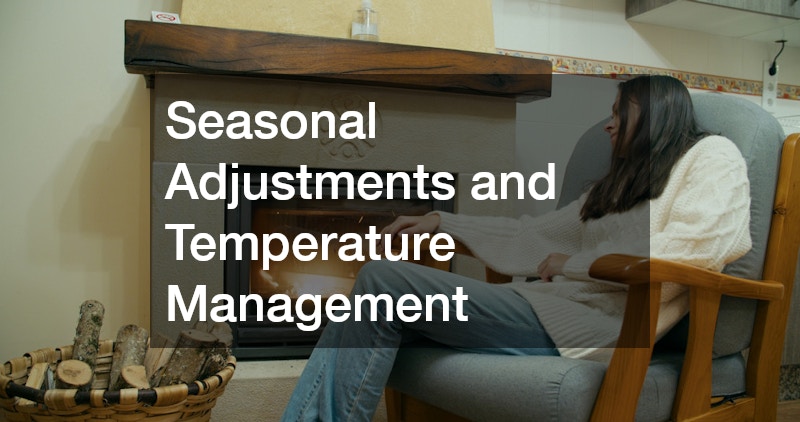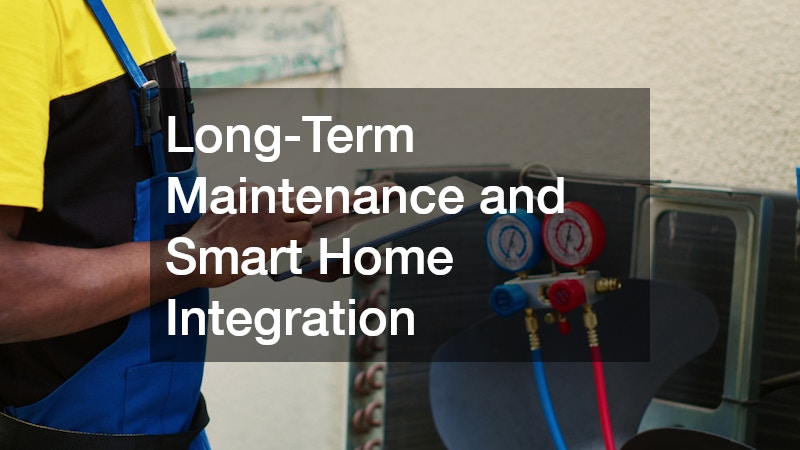A comfortable home begins with the right indoor temperature. Whether it’s the warmth of winter or the cool relief of summer, the balance between comfort and efficiency depends on understanding the normal temperature in a house. Too warm and energy bills skyrocket; too cold and comfort and health begin to decline. Finding and maintaining this balance is both a science and an art, requiring a mix of good insulation, reliable HVAC systems, and mindful household habits.
The normal temperature in a house is influenced by many factors—regional climate, home design, insulation quality, and the efficiency of heating and cooling systems. Maintaining it consistently not only ensures personal comfort but also prevents strain on your energy systems and keeps your home’s interior structure healthy.
This guide explores what defines the normal indoor temperature, how to maintain it throughout seasonal changes, and which professional services—from HVAC specialists to roofing and window experts—play essential roles in keeping your home climate steady year-round.
What Defines the Normal Temperature in a House
The normal temperature in a house is generally considered to be between 68°F and 72°F in colder months and between 74°F and 78°F during warmer seasons. This range accommodates most people’s comfort levels while supporting energy efficiency. However, “normal” varies based on household preferences, building structure, and external climate conditions.
Temperature isn’t just about comfort—it’s about health, energy use, and home preservation. When temperatures fluctuate drastically, materials like wood and drywall expand and contract, leading to cracks or warping. Maintaining a consistent temperature minimizes such damage, stabilizing humidity levels and ensuring your home’s structure remains intact. One of the best ways to maintain this balance is through preventive maintenance. Over time, heating systems lose efficiency and can strain under heavy use, especially during colder seasons. Partnering with a local heating repair specialist helps ensure your system operates efficiently, distributes heat evenly, and maintains stable temperatures.
Programmable and smart thermostats have revolutionized how homeowners manage the normal temperature in a house. They automatically adjust based on occupancy, learning your schedule to conserve energy without sacrificing comfort. This precision control ensures steady indoor conditions while preventing unnecessary heating or cooling when you’re not home. The “normal” temperature ultimately depends on striking a balance between comfort and efficiency. By aligning personal preferences with energy-conscious settings and timely maintenance, you can maintain a consistent, comfortable home atmosphere year-round.
Seasonal Adjustments and Temperature Management
Seasonal changes demand different approaches to temperature management. While the normal temperature in a house remains relatively stable, how it’s maintained varies between winter and summer. During cold months, homes rely on heating systems to maintain warmth, while air conditioning takes over when temperatures climb.
In winter, lowering the thermostat by 7–10°F for eight hours per day—typically when you’re asleep or away—can save up to 10% on heating bills annually. Layering clothing and using insulated curtains or rugs adds warmth naturally without additional energy costs. Regular maintenance of heating systems prevents breakdowns and ensures your home maintains an even temperature. On the other hand, summer brings a different challenge. Rising outdoor temperatures can quickly overwork your air conditioner if your home isn’t properly insulated. Ensuring regular air conditioning repair and cleaning helps your cooling system run efficiently. Clean filters, sealed ducts, and properly calibrated thermostats prevent strain and maintain optimal indoor comfort.
Ceiling fans are also powerful allies in controlling indoor climate—they help circulate air evenly, reducing the workload on cooling systems. The use of blackout curtains or reflective window films minimizes solar heat gain, keeping rooms cooler naturally. Seasonal adaptability doesn’t just save energy—it improves comfort and prevents damage caused by extreme temperature fluctuations. By staying ahead of maintenance needs and optimizing system performance, homeowners can ensure the normal temperature in a house remains consistent through every season.
The Role of HVAC Systems in Indoor Comfort
Your heating, ventilation, and air conditioning system is the foundation of home comfort. It regulates indoor temperatures, controls humidity, and filters air for improved quality. Without a well-functioning HVAC system, maintaining the normal temperature in a house becomes nearly impossible.
Routine maintenance is vital to performance. Filters should be replaced every one to three months, and air ducts should be inspected for leaks or blockages. Regular cleaning prevents dust buildup that restricts airflow and lowers efficiency. For comprehensive service, homeowners should partner with local HVAC companies that provide inspections, tune-ups, and performance diagnostics. A well-maintained HVAC system evenly distributes conditioned air throughout your home, preventing hot or cold spots. Technicians can also identify opportunities for improvement, such as upgrading to high-efficiency units or installing programmable thermostats. Smart systems can even adjust temperatures automatically, ensuring energy isn’t wasted when rooms are unoccupied.
Ventilation also plays a critical role in temperature regulation. Proper airflow ensures that indoor air remains fresh and prevents temperature buildup in certain areas. Balanced ventilation systems bring in fresh air without compromising energy efficiency. Investing in maintenance plans with trusted local HVAC companies ensures your system continues operating efficiently year-round, sustaining comfort and protecting the long-term health of your home’s climate system.
Modern Upgrades: Efficiency and Central Systems
Technology has transformed how homeowners control indoor environments. Modern heating and cooling systems are designed with efficiency in mind, reducing energy waste and maintaining temperature balance with greater precision. Upgrading older systems can significantly improve how easily you achieve the normal temperature in a house.
One of the most impactful upgrades is a central air installation service. Central air systems distribute cooled or heated air evenly throughout the home, using ductwork to maintain consistent conditions. Unlike window units or portable systems, central air is quieter, more efficient, and better integrated into modern smart home systems. Newer systems also use eco-friendly refrigerants and variable-speed compressors that adapt to your home’s cooling needs in real time. When combined with smart thermostats, they create a responsive, energy-efficient environment that ensures stable comfort.
Upgrading duct insulation and sealing any leaks can further enhance system performance. An HVAC technician will perform load calculations to ensure your new system is properly sized—an oversized or undersized unit can lead to inefficiencies, uneven temperatures, and premature wear. These modern systems are investments in comfort and sustainability. Not only do they help maintain the normal temperature in a house, but they also improve indoor air quality and reduce monthly utility expenses. Partnering with a certified central air installation service ensures correct sizing, installation, and long-term reliability for your home.
Troubleshooting Imbalances and Hot/Cold Spots
Few things are as frustrating as walking into a room that feels several degrees different from the rest of your house. Temperature imbalance is a common issue, often stemming from poor airflow, insulation gaps, or aging equipment. These discrepancies disrupt the normal temperature in a house, making comfort inconsistent.
Common causes include clogged filters, blocked vents, unbalanced ductwork, and thermostat misplacement. Rooms farther from HVAC systems or with large windows often experience more temperature variation. Regular inspections and cleaning can address many of these problems before they escalate. When DIY fixes aren’t enough, professional technicians can perform diagnostics to identify the root cause. They may recommend local AC repairs to fix refrigerant leaks, malfunctioning blowers, or faulty compressors that hinder cooling efficiency. Repairs like these restore system balance and improve airflow consistency across rooms.
Insulation also plays a crucial role in maintaining equilibrium. Poor insulation allows conditioned air to escape, forcing HVAC systems to work harder. Weatherstripping, sealing leaks, and adding attic insulation can make a significant difference in maintaining even temperatures. Smart zoning systems can further help by allowing separate thermostatic control for different sections of the home. This ensures that each room reaches your preferred setting, keeping the normal temperature in a house uniform while reducing unnecessary energy consumption.
Structural Factors: Roofing, Insulation, and Exteriors
The exterior shell of your home has a massive influence on indoor comfort. A poorly insulated roof, drafty windows, or worn-out siding can all undermine efforts to maintain the normal temperature in a house. The structure must work in harmony with your HVAC system to retain heat or cool air effectively.
Aging or damaged roofs are among the leading causes of energy loss. Cracks, gaps, and insufficient insulation let heat escape during winter and absorb excess heat in summer. Partnering with local roofing contractors ensures your roof is properly sealed and ventilated. Reflective materials and cool-roof coatings can also minimize solar heat gain, helping reduce cooling costs. Exterior siding contributes both aesthetic appeal and functional insulation. Modern insulated siding materials—like vinyl, fiber cement, or engineered wood—help reduce heat transfer and block drafts. Upgrading outdated siding can drastically improve your home’s energy efficiency while enhancing curb appeal.
Windows are another critical factor. Gaps around frames or single-pane glass allow temperature fluctuations that disrupt comfort. Working with window contractors to install double or triple-pane energy-efficient windows helps retain conditioned air and keeps outdoor temperatures at bay. Together, roofing, siding, and windows create the first line of defense against external temperature changes. A structurally sound home helps maintain the normal temperature in a house more consistently, reducing energy consumption and keeping your HVAC system from overworking.
Supporting Systems That Influence Home Temperature
Beyond heating and cooling, other systems within your home contribute indirectly to temperature stability. Efficient plumbing, insulation, and roofing all play supporting roles in maintaining the normal temperature in a house.
Your water heating system, for instance, releases warmth into nearby spaces and influences humidity levels. Older or poorly insulated water heaters can cause temperature fluctuations and unnecessary energy loss. Timely water heater replacements ensure a consistent hot water supply and improved energy efficiency. Modern tankless models heat water on demand, reducing wasted energy and minimizing heat radiation that could alter indoor comfort levels.
Roof insulation is another key element. A compromised roof allows air leaks that let conditioned air escape and outside air enter. foam roof repair helps restore insulation and sealing, preventing temperature inconsistencies. Foam roofing not only boosts thermal resistance but also extends roof life, making it a smart investment for long-term efficiency.
Ventilation systems—such as attic fans and air exchangers—also balance indoor air quality and temperature. They remove stale, humid air and bring in fresh outdoor air without affecting energy performance. By addressing these interconnected systems, homeowners create a stable, efficient environment that supports the normal temperature in a house year-round. Regular inspections of plumbing, roofing, and ventilation can help detect issues early and sustain optimal comfort levels.
Long-Term Maintenance and Smart Home Integration
Consistency in home temperature doesn’t happen by chance—it requires deliberate care and long-term maintenance. Ensuring the normal temperature in a house is steady throughout the year means taking proactive steps to keep your systems running efficiently and upgrading when necessary.
Routine inspections by HVAC professionals prevent small issues from becoming costly breakdowns. Annual or semi-annual servicing helps maintain efficiency, reduce energy costs, and extend system lifespan. This includes cleaning coils, replacing filters, checking refrigerant levels, and ensuring all components function properly. Homeowners should also schedule roof and siding inspections annually. Damaged exterior materials compromise insulation and allow conditioned air to escape. Similarly, well-sealed windows prevent drafts and maintain equilibrium. Partnering with reliable window contractors for upgrades and maintenance keeps your home energy-efficient and comfortable.
Technology has made home temperature regulation more intuitive. Smart home systems allow remote control of heating and cooling from smartphones or voice assistants. These devices can track your habits, adjust temperatures automatically, and provide insights into energy usage. Combined with preventive services such as local heating repair, they make it easy to sustain a consistent indoor climate.
Upgrading insulation, installing energy-efficient windows, and sealing air leaks all contribute to achieving and preserving the normal temperature in a house. The investment in long-term care not only enhances comfort but also increases property value and reduces carbon footprint—making your home efficient, modern, and sustainable.
A Comfortable and Balanced Home for Every Season
The normal temperature in a house isn’t just a number—it’s the foundation of home comfort, efficiency, and health. Achieving it requires a combination of reliable systems, structural integrity, and consistent maintenance. From HVAC upkeep and air conditioning repair to insulation, roofing, and window upgrades, each element of your home contributes to overall temperature stability.
By investing in professional services—such as local HVAC companies, central air installation service, foam roof repair, and water heater replacements—homeowners can enjoy lasting comfort, lower energy bills, and reduced environmental impact.
A balanced home temperature promotes relaxation, productivity, and overall well-being. With smart upgrades, seasonal awareness, and regular care from trusted professionals, you can maintain a steady indoor climate no matter the weather outside. Ultimately, understanding and sustaining the normal temperature in a house means building a home that feels right—every day, in every season.





